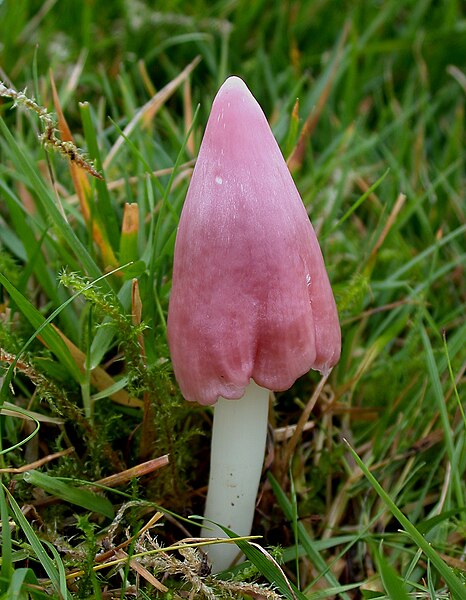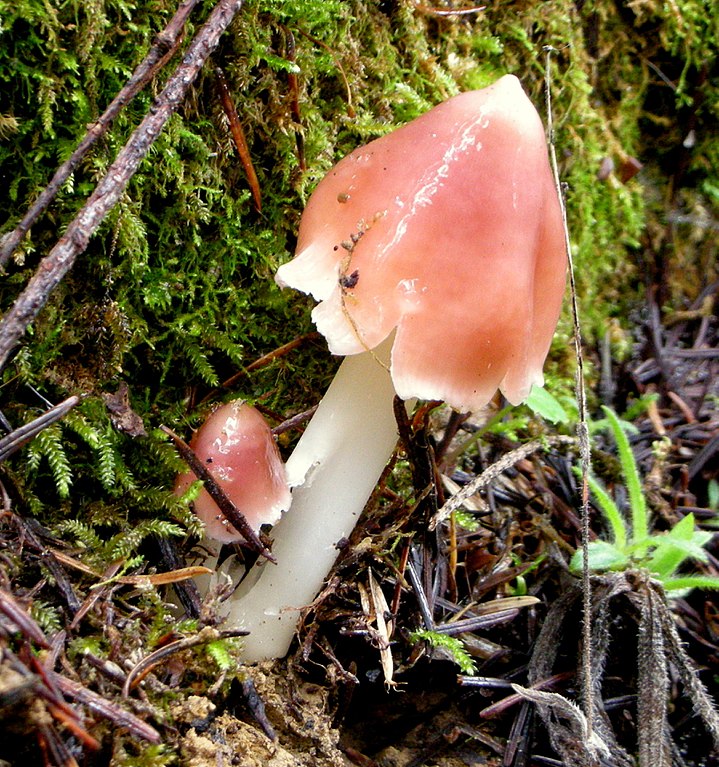Hygrocybe calyptriformis, commonly known as the Pink Waxcap or Ballerina Waxcap, is a distinctive and colorful mushroom that attracts both mycologists and nature enthusiasts.
This guide delves into the various aspects of Hygrocybe calyptriformis, including its identification, habitat, ecological significance, and interesting facts.

Identification
Here is how you can identify Hygrocybe calyptriformis in the wild:
Cap
The cap measures 2–6 cm in diameter. Initially, it has a conical shape but flattens out as it matures, often retaining a slight central hump (umbo). The cap color ranges from pale pink to deep rose, sometimes exhibiting a whitish bloom. Its surface feels smooth and slightly sticky when moist.
Gills
The gills of the Pink Waxcap are adnate to adnexed, meaning they are broadly attached to the stem or slightly notched before reaching it. They are a lighter pink compared to the cap, becoming paler towards the edges. The gills are fairly distant from each other, providing a clear view of the underlying flesh.

Stem
The stem, or stipe, measures 3–8 cm in height and 0.5–1 cm in thickness. It is typically pink, matching or slightly lighter than the cap. The stem surface is smooth, and its interior is solid, not hollow. Unlike some other mushrooms, Hygrocybe calyptriformis does not have a ring or volva.
Spore Print
Obtaining a spore print is essential for accurate identification. Hygrocybe calyptriformis produces a white spore print. This process involves placing the cap, gills down, on a piece of paper for several hours to collect the spores.
Flesh
The flesh is thin and fragile, breaking easily when handled. It is white to pale pink and lacks a distinct odor or taste.

Habitat
Pink waxcap thrives in a variety of habitats. It predominantly grows in unimproved grasslands, old lawns, and pastures that are free from fertilizers and pesticides. These mushrooms prefer moist, well-drained soils with low nutrient levels. They can also be found in mossy areas within woodlands and heathlands.
Geographic Distribution
Pink waxcap mushroom has a widespread but scattered distribution. In Europe, it is found in countries such as the United Kingdom, Ireland, France, and the Netherlands. It also appears in parts of North America, particularly in the eastern United States and Canada.
Hygrocybe calyptriformis Look Alikes
When identifying Hygrocybe calyptriformis, it is essential to be aware of its look-alikes to avoid confusion. Here are some similar species and tips on distinguishing them:
Hygrocybe punicea (Crimson Waxcap)
Hygrocybe punicea, also known as the Crimson Waxcap, has a deep crimson red cap that sometimes fades to orange-red with age. It is generally larger and more robust than pink waxcap. Its gills are yellowish to pale orange and are adnate to slightly decurrent, meaning they attach broadly to the stem or run slightly down it. The stem is yellow to orange, sometimes with a reddish base, and is solid and slightly fibrous. .
Hygrocybe coccinea (Scarlet Waxcap)
Hygrocybe coccinea, known as the Scarlet Waxcap, features a bright scarlet red cap that is convex to flat with age and sometimes has a central depression.
Its gills are yellow to orange and adnate, meaning they attach broadly to the stem. The stem is yellow to orange-red, often hollow and brittle. T
he brighter red cap and the yellow to orange gills and stem set Hygrocybe coccinea apart from the pink tones of pink waxcap.
Hygrocybe conica (Blackening Waxcap)
Hygrocybe conica, or the Blackening Waxcap, has a bright red to orange cap that is conical to bell-shaped and blackens with age or when bruised. The gills are pale yellow and adnate to slightly decurrent. Its stem is yellow to orange and also blackens like the cap. The tendency to blacken when damaged and the conical shape of the cap distinguish Hygrocybe conica from Hygrocybe calyptriformis.
Hygrocybe psittacina (Parrot Waxcap)
Hygrocybe psittacina, known as the Parrot Waxcap, starts with a green cap when young, which matures to yellow or orange with green remnants. The cap is conical to convex. Its gills are greenish at first, turning yellow with age, and the stem is greenish, becoming yellow or orange. The green coloration, especially in young specimens, is a key characteristic that differs from the pink hues of Hygrocybe calyptriformis.
Is Hygrocybe Calyptriformis Edible?
Hygrocybe calyptriformis is not considered edible. While it is non-toxic, several factors make it unsuitable for consumption:
- Fragile Texture: The flesh of this pink mushroom is thin and fragile, breaking easily when handled. This makes it difficult to prepare and cook in a way that would be appealing.
- Lack of Flavor: Unlike some mushrooms prized for their distinctive flavors, this fungi lacks a significant taste, making it unappealing as a culinary ingredient.
- Conservation Concerns: Given its role as an indicator species for high-quality, undisturbed grasslands, foraging for these mushrooms could potentially harm their populations and the delicate ecosystems they inhabit.
For these reasons, it is best to appreciate pink waxcap for its ecological significance and beauty rather than as a food source.
Interesting Facts About Hygrocybe Calyptriformis
- Unique Appearance: It stands out with its striking pink color, making it one of the more visually appealing fungi in its habitat.
- Edibility: Although it is non-toxic, Hygrocybe calyptriformis is not considered edible due to its fragile texture and lack of substantial flavor.
- Waxcap Group: This species belongs to the Hygrophoraceae family, commonly known as waxcaps. They are named for their waxy gills and vibrant colors.
- Scientific Naming: The name “calyptriformis” comes from the Latin “calyptra,” meaning “veil” or “hood,” and “formis,” meaning “shape,” referring to the cap’s conical shape.
Frequently Asked Questions
Is Hygrocybe calyptriformis rare?
While not rare, Hygrocybe calyptriformis has a scattered distribution and is more common in areas with well-preserved, unimproved grasslands. Its presence can be an indicator of high-quality habitats.
Can I eat Hygrocybe calyptriformis?
Although it is not toxic, Hygrocybe calyptriformis is not recommended for consumption. Its fragile texture and lack of significant flavor make it unappealing as an edible mushroom.
What time of year can I find Hygrocybe calyptriformis?
Hygrocybe calyptriformis typically fruits in the autumn, from September to November. However, this can vary depending on local climate conditions and specific habitats.
Conclusion
The pink waxcap is a captivating mushroom with a unique role in its ecosystem. Its identification relies on key features such as the pink conical cap, adnate to adnexed gills, and a smooth stem.
Thriving in undisturbed grasslands and mossy woodlands, it serves as an indicator of healthy environments. Conservation efforts are crucial to preserving its habitat and ensuring the survival of this and other waxcap species. By understanding and appreciating pink waxcap, we can better protect the delicate balance of our natural world.


